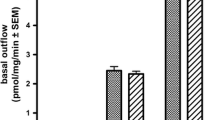Abstract
Evidence has mounted that kainic acid (KA), a powerful neuroexcitatory and neurotoxic agent, acts at a specific class of receptors distinct from those mediating the excitatory actions of glutamate1–3. This has prompted a search for the endogenous ligand for the KA-specific receptors. Recently, Ruck et al.4 reported that the naturally occurring folic acid derivative methyltetrahydrofolate (MTHF) is a potent and specific competitor for KA-binding sites in rat cerebellar membranes, having one-tenth the binding activity of KA at these sites. They suggested that MTHF may be the endogenous KA receptor ligand. Olney et al.5 found that injections of various folates—MTHF, folic acid (pteroyl-L-glutamic acid, PGA), or folinic acid (formyltetrahydrofolate, FTHF)—into rat amygdala and striatum produced KA-like seizures and associated brain damage at sites distant from the site of injection. However, these folates did not mimic the direct neurotoxic effects of KA at the injection site. Furthermore, Roberts et al.6 reported that MTHF injected into rat cerebellum produced slower and less complete neuronal degeneration than did KA and, unlike KA and glutamate, did not increase cerebellar cyclic GMP levels. In light of the contradictory results from these binding, histological and biochemical studies, we have tested the electrophysiological equivalency of KA and the folates in rat olfactory cortex slices. KA is a potent agonist at the receptors of the terminal synapses of the lateral olfactory tract (LOT); in fact, the natural transmitter at this synapse appears to act at a KA-preferring receptor7. Also, olfactory cortex is extremely sensitive to the neurotoxic action of KA8. We report here that MTHF, FTHF and PGA had little or no effect on LOT-stimulated field potentials even at millimolar concentrations, whereas KA exhibited excitatory effects at concentrations as low as 5×10−7 M. It therefore seems unlikely that MTHF or the other folates are endogenous ligands for the KA receptor in olfactory cortex.
Similar content being viewed by others
References
Hall, J. G., Hicks, T. D. & McLennan, H. Neurosci. Lett. 8, 171–175 (1978).
Baudry, M. & Lynch, G. Eur. J. Pharmac. 57, 283–285 (1979).
Watkins, J. C. Adv. Biochem. Psychopharmac. 29, 205–212 (1981).
Ruck, A., Kramer, S., Metz, J. & Brennan, M. J. W. Nature 287, 852–853 (1980).
Olney, J. W., Fuller, T. A. & de Gubareff, T. Nature 292, 165–166 (1981).
Roberts, P. J., Foster, G. A. & Thomas, E. M. Nature 293, 654–655 (1981).
Hori, N., Auker, C. R., Brahman, D. J. & Carpenter, D. O. Cell. molec. Neurobiol. 1, 115–120 (1981).
Olney, J. W. & de Gubareff, T. in Kainic Acid as a Tool in Neurobiology (eds McGeer, E., Olney, J. W. & McGeer, P. L.) 201–217 (Raven, New York, 1978).
Davies, J. & Watkins, J. C. Biochem. Pharmac. 22, 1667–1668 (1973).
Richards, C. D. J. Physiol., Land. 222, 209–231 (1972).
Richards, C. D. & Sercombe, R. J. Physiol., Land. 211, 571–584 (1970).
Author information
Authors and Affiliations
Rights and permissions
About this article
Cite this article
Auker, C., Braitman, D. & Rubinstein, S. Electrophysiological action of kainic acid and folates in the in vitro olfactory cortex slice. Nature 297, 583–584 (1982). https://doi.org/10.1038/297583a0
Received:
Accepted:
Issue Date:
DOI: https://doi.org/10.1038/297583a0
- Springer Nature Limited





